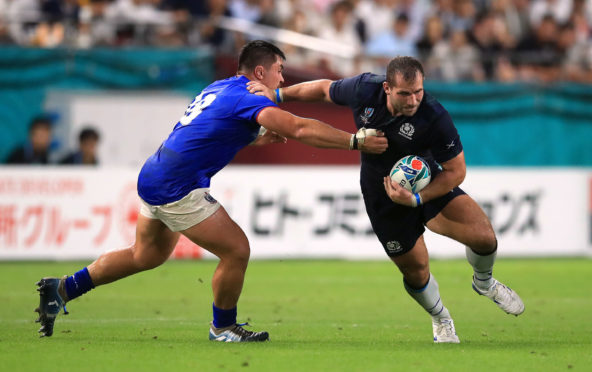How creative can Scotland be to protect precious energy in the short turnaround between the two remaining games of their Rugby World Cup pool?
The Scots face Russia on Wednesday and Japan just four days later, and while it is possible to have entirely separate XVs for those games from the squad of 31 with a bit of selectorial jiggery-pokery, the risk is substantial anyway.
Scotland must play full-on and without tentativeness against the Russians, who’ve proved to be a lot better in Japan than their frank horrendous warm-up results suggested. But every Scot on the pitch is going to be one hit away from failing a Head Injury Assessment that will leave them absolutely no time to be involved against Japan because of statutory concussion protocols.
That’s probably the biggest worry for the team management, and why you won’t see certain key players in the starting team or on the bench. Whether they’re prepared to go the extra yard or not remains to be seen.
Assistant coach Mike Blair conceded yesterday there would probably be two or more “first team” players picked to start against Russia. The situation is complicated further by a number of players who have not made a habit of going the full 80 in their recent careers – John Barclay, Ryan Wilson, any of the front rowers to name but a few.
The key deficit areas are the back row and the back three. Scotland could be very creative and start Fraser Brown as an openside alongside Barclay and Wilson and give all of the back row against Samoa a break. Brown trains as an emergency seven every week and was used in that role a couple of times in the warm-ups.
Equally, although the stresses involved in this short turnaround are less for the outside backs, Scotland could easily put George Horne out on the wing, play Henry Pyrgos at scrum-half and give (probably) Darcy Graham a break. That way the Scots could start a XV where none of the team against Samoa have to start the game.
Of course, this makes a lot of dangerous assumptions about the quality of the Russians. Japan and Samoa’s first teams took a good while to subdue them and the history of Scottish sport against so-called minnow opposition should set the alarm bells ringing loudly.
Rest and be thankful
The Scots pool schedule has been called unfair by some, but it’s an inevitable circumstance of having a tournament this big.
It’s already a pretty unwieldy schedule, and each team involved (apart from Japan but fair enough, it’s their tournament) has a short turnaround at some point. It just so happens that Scotland’s is at the sharp end of the pool campaign and against the hosts.
You could ease matters by reducing the pool numbers to four, but part of the purpose of having this event is to grow the game worldwide and you don’t do that by shutting teams out, unless you’re cricket obviously.
More off days doesn’t work either; the time between games stretches the patience of the watching public. The tournament is more than six weeks long already.
The only solution – and it’s certainly not a cure-all – is surely to allow the teams to protect the players by increasing squad sizes. 31 is inadequate and there should be at least three more. World Rugby should be paying attention to this rather than technology to police offside lines.
Darcy’s dogsbody duties
It’s a tradition of rugby tours that the youngest player becomes the tour dogsbody, given all the menial tasks – some conjured up specifically just to be irritating – that have to be done.
Darcy Graham must have been disappointed that Matt Fagerson was left out at the last cut as it meant he was the youngest Scotland squad members, but it appears his team-mates have left the young wing off lightly.
He found a pile of white shirts with orders to iron them before the squad cap ceremony in Nagasaki in the first week, but did his due diligence.
Darcy’s other main duty is to look after the squad’s communal guitar, carrying it from venue to venue. Oddly Vern Cotter, who you wouldn’t think of as a thoughtful singer-songwriter type, had staff buy the guitar in America during his first tour of head coach back in 2014 to encourage a few sing-songs.
The acoustic has been a fixture ever since. Sean Maitland is the squad’s acknowledged master guitarist, with Duncan Taylor ranked second on the list. Darcy, despite having to carry it everywhere, can’t get a note out of it.


